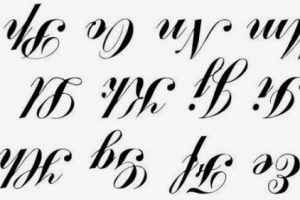If you have ever marveled at the beauty and elegance of calligraphy writing and wondered how to achieve it yourself, you are not alone. Calligraphy writing is a timeless art that has captivated people for centuries, from the ancient Chinese and Arabic calligraphers to the modern Western calligraphers. With the right tips, techniques, and tools, you too can learn how to create stunning calligraphy writing that will impress and inspire.
What is calligraphy writing?
Calligraphy writing is the art of creating beautiful and decorative handwriting or lettering using a pen, brush, or other writing tool. It is often used for formal or artistic purposes, such as wedding invitations, certificates, manuscripts, and artwork, and can be found in various styles, scripts, and alphabets from around the world. Calligraphy writing requires not only skill and patience but also a deep appreciation for aesthetics and expression.
Why learn calligraphy writing?
Learning calligraphy writing can offer many benefits, both practical and creative, such as:
1. Improved handwriting: Practicing calligraphy writing can help improve your regular handwriting by developing your muscle memory, hand-eye coordination, and penmanship skills.
2. Personal expression: Calligraphy writing allows you to express yourself and your ideas in a unique and beautiful way, whether through writing letters, poems, or quotes.
3. Creative outlet: Calligraphy writing can be a relaxing and rewarding hobby that can inspire your creativity and imagination, as well as provide a sense of accomplishment and satisfaction.
4. Professional opportunities: Calligraphy writing can also lead to professional opportunities, such as freelance work, teaching, or designing custom typography for clients.
How to start learning calligraphy writing?
If you are new to calligraphy writing or want to improve your skills, here are some steps you can follow:
1. Choose a style: There are many styles of calligraphy writing to choose from, such as Gothic, Italic, Copperplate, Spencerian, or Modern. Each style has its own characteristics, rules, and tools, so it’s important to research and experiment with different styles to find the one that suits you best.
2. Get the right tools: Calligraphy writing requires specific tools, such as a calligraphy pen or brush, ink, paper, ruler, and eraser. It’s essential to invest in good quality tools that match your style and level of expertise, as they can greatly affect the outcome of your writing.
3. Learn the basics: Before diving into complex calligraphy writing, it’s important to learn the basic strokes, letters, and techniques of your chosen style. There are many online tutorials, books, and courses that can teach you the fundamentals of calligraphy writing, as well as provide practice sheets and exercises.
4. Practice regularly: Like any skill, calligraphy writing requires practice, patience, and persistence. Set aside some time each day or week to practice your writing, starting with simple letters and gradually progressing to words, phrases, and sentences. Don’t be afraid to make mistakes or experiment with different variations and flourishes.
5. Join a community: Calligraphy writing can be a solitary activity, but it doesn’t have to be. Joining a calligraphy club, group, or forum can provide you with feedback, inspiration, and motivation, as well as expose you to different styles and techniques from other calligraphers.
<h
2> Tips and Techniques for Calligraphy Writing
Here are some tips and techniques to help you master the art of calligraphy writing:
1. Posture and grip: Sit comfortably and upright, with your feet flat on the ground and your shoulders relaxed. Hold the pen or brush at a 45-degree angle, and grip it lightly but firmly, using your fingertips and thumb.
2. Pressure and speed: Apply consistent pressure on the downstrokes and release pressure on the upstrokes, to create contrast and variation in your writing. Control your speed and rhythm, and avoid rushing or hesitating.
3. Letter formation: Follow the guidelines and proportions of your chosen style, and practice each letter separately before combining them into words and sentences. Pay attention to details such as spacing, slant, and shape.
4. Ink and paper: Choose high-quality ink and paper that are suitable for your style and tools. Experiment with different colors, textures, and effects, and be aware of the drying time and bleed-through.
5. Flourishing and decoration: Once you feel comfortable with the basic letterforms, you can start adding flourishes and decorations to your writing, such as loops, swirls, dots, or shadows. Be creative but consistent, and avoid overdoing it.
Tools and Materials for Calligraphy Writing
To get started with calligraphy writing, you will need some essential tools and materials, such as:
1. Calligraphy pen: There are different types of calligraphy pens, such as dip pens, fountain pens, brush pens, and markers. Each type has its own advantages and disadvantages, so it’s important to choose the one that suits your style and level of expertise.
2. Ink: Calligraphy ink comes in various colors, formulas, and viscosities, such as water-based, oil-based, acrylic, or metallic. It’s important to choose ink that is compatible with your pen and paper, and that dries quickly and evenly.
3. Paper: Calligraphy paper should be smooth, thick, and absorbent, to prevent bleeding and feathering of the ink. Popular types of calligraphy paper include Bristol board, vellum, parchment, or rice paper.
4. Ruler and T-square: These tools can help you create straight and consistent guidelines for your writing, and measure the spacing and proportions of your letters.
5. Eraser and correction fluid: These tools can help you fix mistakes or smudges in your writing, without ruining the entire piece.
Conclusion
Calligraphy writing is a beautiful and rewarding art that requires practice, patience, and passion. By following the tips, techniques, and tools outlined in this article, you can start your journey towards mastering the art of calligraphy writing. Whether you want to improve your handwriting, express your creativity, or pursue professional opportunities, calligraphy writing can offer you a world of possibilities and inspiration. Happy writing!









Add Comment